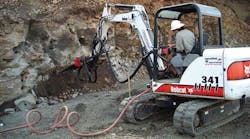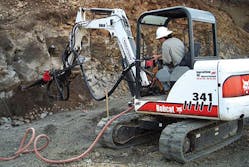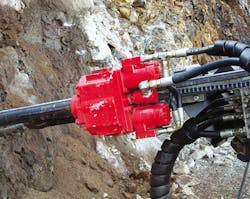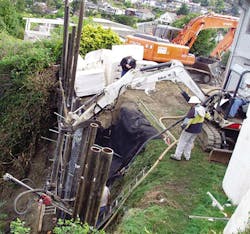When you have to drill large holes into rock, hydraulics technology is often the first choice for powering heavy-duty mining and construction equipment. But drilling into solid rock requires more than torque and speed applied to a drill. This demanding application requires a percussion drill, which pounds its way through rock as it twists deeper into the hole.
Many companies offer percussion drills, but only a handful offer equipment that stands up to the rigors of mining and heavy construction applications. TEI Rock Drills, Montrose, Colo., designed its TE250 hydraulic percussion drill with features that leave other equipment in the dust. Even though the TE250 develops high torque and generates heavy percussion to pulverize rock, it is compact and lightweight by taking full advantage of hydraulics technology.
TEI's Glenn Patterson, vice president, special projects, explained, "The TE250 was built as a lightweight percussion drill for installing tie back bars as soil nails or drilling a hole in rock where other drills cannot reach because of size and weight. It's hydraulic top hammer is lighter than any other drill in its class of percussion power (7 kW of blow force) and rotational torque (200 lb-ft). Combined with an aluminum guide feed system, it makes the lightest system on the market with this kind of power."
Patterson said the drilling system is controlled through hydraulic valves. Manually operated valves are standard, with electrohydraulic valves a popular option because they allow remote operation of the machine — either though wired controls or radio remote controls. Electric controls also provide greater mobility and better access to drilling operations.
The drilling system is usually sold as an attachment for excavators, mini excavators, shown, skid steer loaders, or loader backhoes. Patterson added, "A one-man portable version is also popular because of its low overall weight and the accessibility into confined drilling areas. These versions, however, require the operator to have knowledge of drill operation for the method being used (rotary, percussion, casing, etc.)."
Hydraulics make it happen
The TE250 relies on hydraulics to produce both rotary and percussion functions. The rotary function requires flow of 6 to 8 gpm, and percussion requires 10 to 12 gpm. Also, a feed system advances the drill assembly into the drilled hole and requires 3- to 5-gpm flow. In addition, compressed air plays a role to blow debris out of the drilled hole.
The rotary drive has two motors and two speeds. The speed control is mounted directly onto the drill because once it is set up, the operator usually doesn't need to change speeds. Two torque settings produce torque to 100 lb-ft in the low setting and 200 lb-ft in the high setting.
"The percussion system," said Patterson, "can reach a frequency of 4000 blows per minute, which gives it the performance of larger drills. There are two stroke positions for the hammer — long and short. The short stroke is used when higher frequencies are needed, such as hard rock. The longer stroke runs at lower frequencies and gives more of a hit, which is more suitable for softer materials, such as soil or fractured rock. The original design did not have a stroke control on the percussion unit. This was incorporated to accommodate a wider variety of drilling conditions. The feed system can develop 2500 lb of thrust or pull. Thrust is controlled through a pressure-reducing valve to control the infeed drilling."
Patterson explained, "Hydraulic fluid power was chosen because of efficient operation and compact size. Hydraulically powered tools have become a standard in the construction and mining industries. Even if electromechanical components could fit into the confined spaces hydraulics do, they could not hold up to the extreme conditions of these applications."
For more information on, visit www.teirockdrills.com




